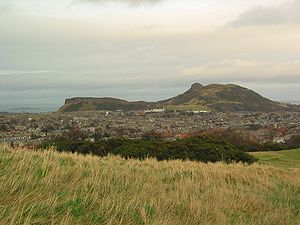
Crag and tail
Encyclopedia


Glacier
A glacier is a large persistent body of ice that forms where the accumulation of snow exceeds its ablation over many years, often centuries. At least 0.1 km² in area and 50 m thick, but often much larger, a glacier slowly deforms and flows due to stresses induced by its weight...
or ice sheet
Ice sheet
An ice sheet is a mass of glacier ice that covers surrounding terrain and is greater than 50,000 km² , thus also known as continental glacier...
passes over an area that contains a particularly resistant rock formation (often a granite
Granite
Granite is a common and widely occurring type of intrusive, felsic, igneous rock. Granite usually has a medium- to coarse-grained texture. Occasionally some individual crystals are larger than the groundmass, in which case the texture is known as porphyritic. A granitic rock with a porphyritic...
, volcanic plug
Volcanic plug
A volcanic plug, also called a volcanic neck or lava neck, is a volcanic landform created when magma hardens within a vent on an active volcano. When forming, a plug can cause an extreme build-up of pressure if volatile-charged magma is trapped beneath it, and this can sometimes lead to an...
or some other volcanic structure). The force of the glacier erodes
Erosion
Erosion is when materials are removed from the surface and changed into something else. It only works by hydraulic actions and transport of solids in the natural environment, and leads to the deposition of these materials elsewhere...
the surrounding softer material, leaving the rocky block protruding from the surrounding terrain. Frequently the crag serves as a partial shelter to softer material in the wake of the glacier, which remains as a gradual fan or ridge forming a tapered ramp (called the tail) up the leeward side of the crag.
In older examples, or those latterly surrounded by the sea, the tail is often missing, having been removed by post-glacial erosion.
Examples of such crag and tail formations include:
- The Castle Rock in EdinburghEdinburghEdinburgh is the capital city of Scotland, the second largest city in Scotland, and the eighth most populous in the United Kingdom. The City of Edinburgh Council governs one of Scotland's 32 local government council areas. The council area includes urban Edinburgh and a rural area...
, ScotlandScotlandScotland is a country that is part of the United Kingdom. Occupying the northern third of the island of Great Britain, it shares a border with England to the south and is bounded by the North Sea to the east, the Atlantic Ocean to the north and west, and the North Channel and Irish Sea to the...
, the rock on which Edinburgh CastleEdinburgh CastleEdinburgh Castle is a fortress which dominates the skyline of the city of Edinburgh, Scotland, from its position atop the volcanic Castle Rock. Human habitation of the site is dated back as far as the 9th century BC, although the nature of early settlement is unclear...
stands - Salisbury CragsHolyrood ParkHolyrood Park is a royal park in central Edinburgh, Scotland about a mile to the east of Edinburgh Castle. It has an array of hills, lochs, glens, ridges, basalt cliffs, and patches of whin providing a remarkably wild piece of highland landscape within its area...
and Arthur's Seat, EdinburghArthur's Seat, EdinburghArthur's Seat is the main peak of the group of hills which form most of Holyrood Park, described by Robert Louis Stevenson as "a hill for magnitude, a mountain in virtue of its bold design". It is situated in the centre of the city of Edinburgh, about a mile to the east of Edinburgh Castle... - North Berwick LawNorth Berwick LawNorth Berwick Law is a conical hill which rises incongruously from the surrounding landscape . It overlooks the East Lothian town of North Berwick and stands at 613 ft above sea level.Geologically, the law is a volcanic plug of hard phonolitic trachyte rock of Carboniferous age...
- Three in or near StirlingStirlingStirling is a city and former ancient burgh in Scotland, and is at the heart of the wider Stirling council area. The city is clustered around a large fortress and medieval old-town beside the River Forth...
, including the rock on which Stirling CastleStirling CastleStirling Castle, located in Stirling, is one of the largest and most important castles, both historically and architecturally, in Scotland. The castle sits atop Castle Hill, an intrusive crag, which forms part of the Stirling Sill geological formation. It is surrounded on three sides by steep...
stands

